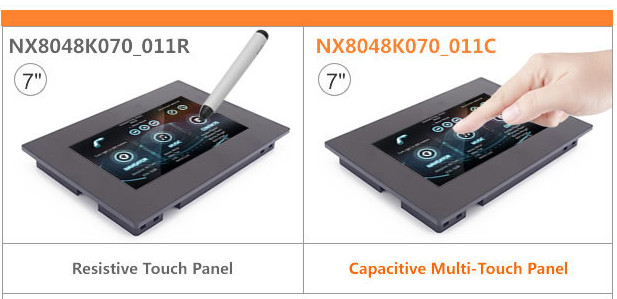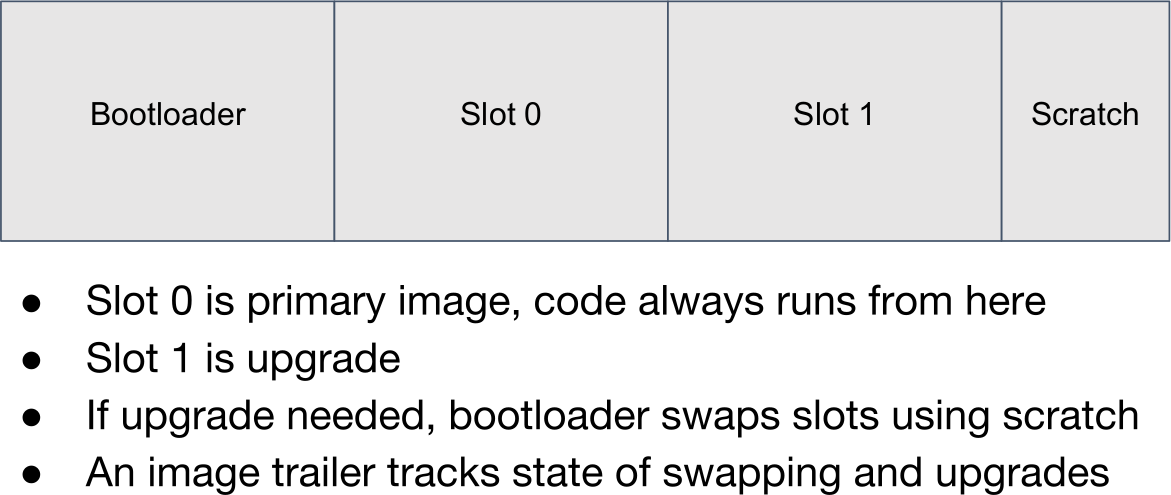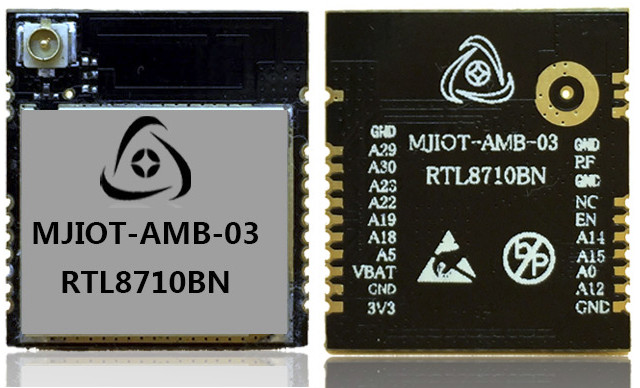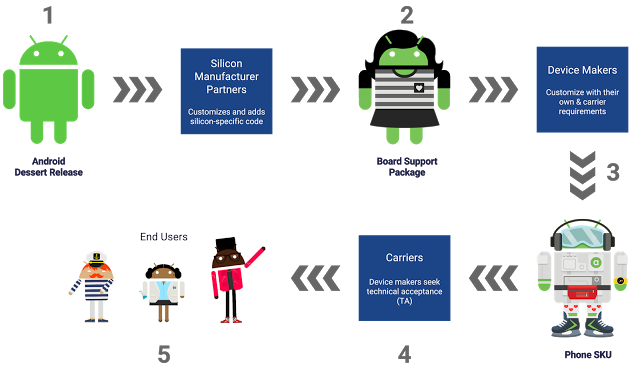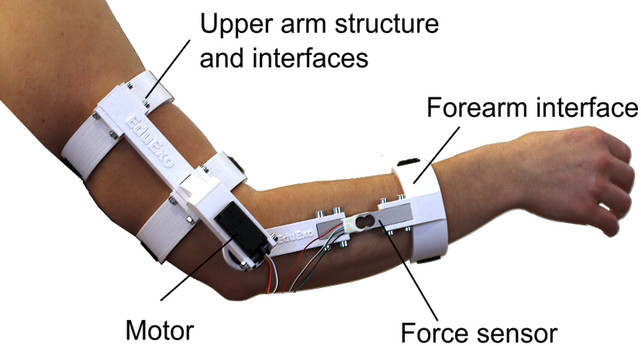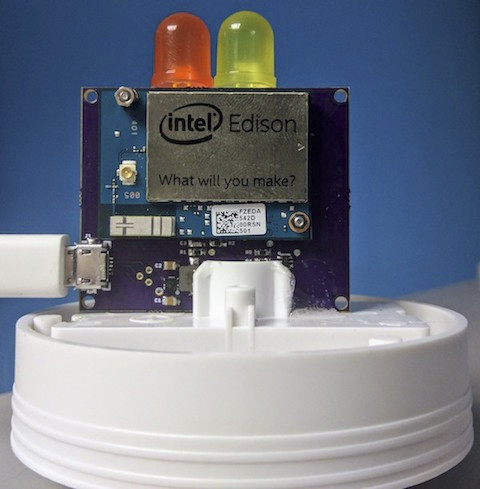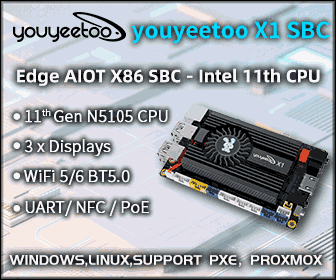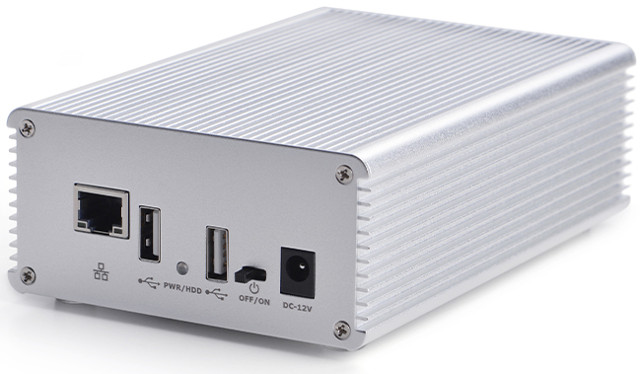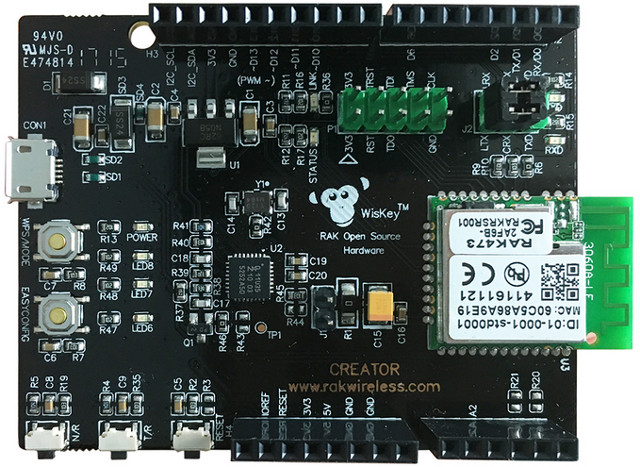Nextion displays are designed to be controlled by MCU boards with the user interface designed in Nextion Editor drag-and-drop tool. ITEAD Studio launched them in 2015, and I played with Nextion 2.4″ and 5.0″ models, but at the time, I found the Windows only Nextion Editor program not to be that user-friendly and inconvenient to use, as for example, UI designs do not automatically scale across all display sizes. The company is now back with a 7″ model, available with resistive or capacitive touch panel, and featuring an ARM7 processor exposing 8 GPIOs. Nextion Enhanced NX8048K070 (_011) specifications: CPU – ARM7 processor @ 108 MHz with 8K RAM, 1024 EEPROM, 1024 bytes instruction buffer Storage – 32MB flash memory, micro SD card slot Display – 7″ TFT display with resistive or capacitive panel; resolution: 800×480; 65K colors; adjustable brightness: 0 to 230 nit Expansion – 8x GPIOs including 4x PWM, […]
MCUBoot is an Open Source Secure Bootloader for IoT / MCUs
Bootloaders takes care of the initial boot sequence on the hardware before the operating system takes over. For example, U-boot is often used in embedded systems as the bootloader before starting the main operating systems such as Linux or FreeBSD. MCUBoot is also a bootloader, but it targets the IoT, here referring to MCU based systems with limited memory and storage capacity, and is born out of work on Apache Mynewt OS, when developers decided to develop the bootloader separately from the operating system. MCUBoot is designed to run on small & low cost systems running on MCU with ~512 KB flash, ~256 KB RAM, and currently supports Zephyr OS and Mynewt, with support for other RTOS also considered. Due to constraint the bootloader uses minimal features with a flash driver, a single thread, and crypto services. The project also aims at solving security and field firmware updates. To address the […]
Realtek RTL8710BN ARM Cortex M4 WiFi MCU, MJIOT-AMB-03 Module & Board, and Ameba 4.0a SDK
We’ve already covered Realtek Ameba ARM Cortex M3 WiSoC several times with their RTL8710AF, RTL8711AM and RT8195AM solutions, but the company has now a new “Ameba Z series” relying on an ARM Cortex M4 core starting with RTL8711BN MCU. RTL8710BN specifications as listed on Realtek website: CPU – ARM Cortex-M4(F) up to 125MHz with FPU (TBC) Memory – 256KB embedded SRAM Storage – 512KB embedded ROM, external flash interface; XIP (eXecut In Place) support Wi-Fi 2.4GHz 1T1R 802.11b/g/n up to 150Mbps; 20MHz and 40MHz WEP, WPA, WPA2, WPS support Security engine – MD5, SHA-1, SHA2-256, DES, 3DES, AES Peripheral Interfaces SDIO Slave 2x UART SPI interface (Master/Slave) 2x I2C interface ADC for voltage management 5x PWM Up to 17x GPIOs Package – QFN-32; 5 x 5 mm AFAIK, other Ameba MCUs do not support XIP, but RTL8710BN and this lowers memory requirements since code can be executed from storage. MJIOT-AMB-03 module […]
Google’s Project Treble To Allow Easier & Faster Updates to a New Android Versions
If you’ve ever purchase a phone with Android X, you may have noticed it takes a long time to get an update to Android Y after Google officially release the latest version. The reason it takes so long, except on Google’s own hardware, is that the latest Android version needs to be update by the Silicon vendor, which then sends a BSP to manufacturers, who in turn brings their own tweaks, with in some cases telecom carriers involved in the last step, before delivering the update the end users. This is normally a time-consuming and costly process for all parties involved. One of the reasons is that while the higher level app API is fairly stable, the Android framework (middleware) interface to the Vendor’s implementation may change greatly between different major Android versions. Google is aiming to fix that with Project Treble, starting with Android O, by providing a stable […]
EduExo DIY Robotic Exoskeleton Kit is Arduino Powered, 3D Printable, Designed for STEM Education (Crowdfunding)
Robotic exoskeletons are used for medical purposes such as helping with the rehabilitation of stroke patients, or enable paraplegics to walk again, as well as in the work place to assist people lifting heavy objects. While it’s possible to learn about the theory about exoskeleton technology, practical experience may help grasping all concepts better. However, there are not many courses available, and exoskeletons are usually expensive, so Volker Bartenbach, PhD at ETH in Zürich, has decided to created EduExo robotic exoskeleton kit for education purpose. The EduExo hardware is based on off-the-shelf components like an Arduino UNO board, a motor, and a force sensor, as well as a rigid exoskeleton structure and cuff interfaces. The latter is optional as you can get the kit without it, and will instead receive the STL files to 3D print the parts yourself. There’s also a handbook to help you get started in several […]
Visualizing Electronics Manufacturing Price Variation with Volume and Lead Time
Google Android Things developers announced a production hardware sample based on Intel Edison module: Android Things is focused on helping developers build production ready devices that they can bring to market. This means building custom hardware in addition to the app software running on the Android Things system-on-module (SoM). As a part of this effort we have released Edison Candle, the first in a series of production samples designed to showcase hardware and software designed to work together. The code is hosted on GitHub and the hardware design files are on CircuitHub. That’s what the Edison Candle looks like. It’s just demo hardware to show how to build a product with a system-on-module (Intel Edison) for Android Things with everything released in Github. You can also purchase the board on CircuitHub, but then I saw the price was around $356 for such a simple board (without Edison). That’s quite a […]
NAS Kit v1.2 Gets Support for NanoPi NEO 2, an UAS Capable USB to SATA Bridge, and an RTC Battery
Last month, FriendlyELEC launched a NAS Dock kit for NanoPi NEO board, but they’ll already removed it from their store. That’s because they have a new version NAS Dock v1.2 that also supports NanoPi NEO 2 with Gigabit Ethernet, replaces JMicron JM20329 by UAS capable JMicron JMS567 USB 3.0 to SATA bridge, and adds an RTC battery. The rest of NAS Dock Kit v1.2 specifications remain the same: 1-bay NAS Dock expansion board with JMicron JMS567 USB 3.0 to SATA bridge SATA connector for 2.5″ HDD drive Extra USB host port On/off switch, and dual color status LED Header to connect NanoPi NEO / NEO 2 board 12V DC power input Dimensions – 151 x 89.7 mm NS-120 aluminum enclosure (154 x 100 x 47.5 mm, 414 grams) Heatsink set for NanoPi NEO / NEO 2 4x M3 6mm screws, 8x M2.5 6 mm screws Four rubber pads Front and back covers […]
$8.80 RAK CREATOR Pro Ameba RTL8711AM WiFi IoT Board Comes with 2MB SDRAM, Up to 64MB SPI Flash
Realtek Ameba is a family of WiFi ARM Cortex M3 micro-controllers for IoT applications, and RTL8710AF got some buzz last year, as modules would sell as low as $2, hereby competing with ESP8266 in terms of price. While the solution was interesting, the community activity around the solution has been slow as ESP8266 already have the community and software support. Other Realtek RTL8195AM and RTL8711AM processors offer much more memory, but at the time, price was not as attractive with Ameba Arduino board based on RTL8195AM selling for $25. But there’s now a new Arduino compatible board made by ShenzhenRAK Wireless Technology (RAK) that comes with RTL8711AM processor with 1MB ROM, 2MB SDRAM, 512KB SRAM, and up to 64MB SPI flash, and sells for just $8.80 + shipping on Aliexpress. CREATOR Pro (Wiskey) board specifications: WiFi Module – RAK473 with Realtek RTL8711AM ARM Cortex M3 MCU @ 166 MHz, 1MB […]


